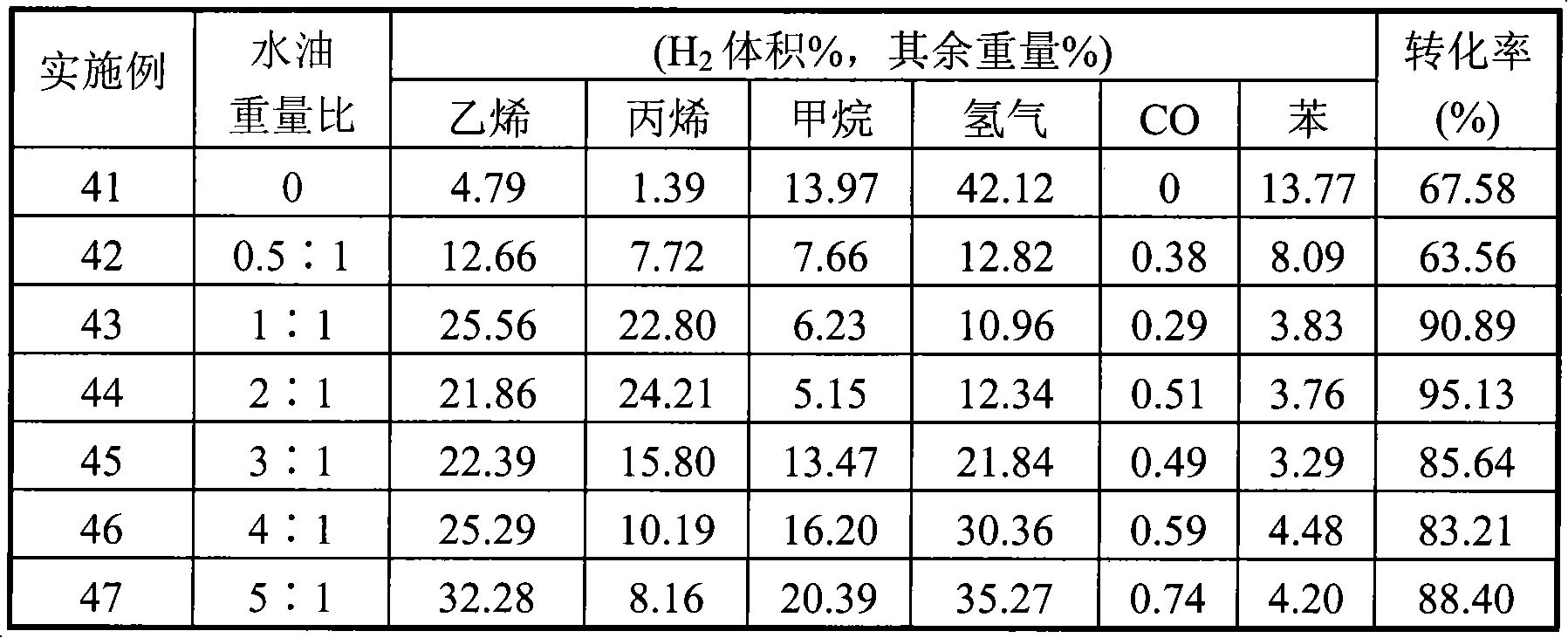Method for preparing ethylene and propylene by benzin naphtha catalytic pyrolysis
A technology for ethylene propylene and catalytic cracking, which is applied in the production of bulk chemicals, chemical instruments and methods, molecular sieve catalysts, etc., can solve the problems of short catalyst life and achieve the effects of improved life and good technical effects
- Summary
- Abstract
- Description
- Claims
- Application Information
AI Technical Summary
Problems solved by technology
Method used
Image
Examples
Embodiment 1
[0016] Take 284 grams of sodium metasilicate, dissolve it into solution A with 300 grams of distilled water, take 33.3 grams of aluminum sulfate, and make solution B with 100 grams of distilled water, slowly pour B solution into A solution, stir vigorously, and then add 24.4 grams of B Diamine, after stirring for 20 minutes, adjust the pH value at 11.5 with dilute sulfuric acid, and control the molar ratio of the sol: Si: Al: ethylenediamine: H 2 O=1:0.1:0.4:40, add seeds containing ZSM-5 and mordenite precursors, stir for 30 minutes, put the mixed solution in an autoclave, keep it at 180°C for 40 hours, then take it out and wash it with water, and heat it at 150°C The intergrown molecular sieve of ZSM-5 and mordenite was obtained by drying and roasting at 550°C. Quantification by XRD diffraction showed that the weight contents of ZSM-5 and mordenite in the intergrown molecular sieve were 95% and 5%, respectively. Using ammonium nitrate solution with a concentration of 5%, exc...
Embodiment 2
[0018] Take 284 grams of sodium metasilicate, dissolve it into solution A with 300 grams of distilled water, take 16.7 grams of aluminum sulfate, and make solution B with 100 grams of distilled water, slowly pour B solution into A solution, stir vigorously, and then add 12.2 grams of B Diamine and 29.4 grams of tetraethylammonium hydroxide (the mixed template is denoted as M), after stirring for 20 minutes, adjust the pH value at 11 with dilute sulfuric acid, and control the molar ratio of the sol: Si: Al: M: H 2 O=1:0.05:0.4:40, add 2.8 grams of beta zeolite seed crystals, put the mixed solution in an autoclave, keep it at 160°C for 40 hours, then take it out, wash it with water, dry it at 150°C, and roast it at 550°C to obtain ZSM -5 / beta zeolite symbiotic molecular sieve, the XRD diffraction pattern is shown in curve 1 in Figure 1, quantitatively by XRD diffraction, it can be known that the weight percentage of ZSM-5 in the symbiotic molecular sieve is 94.6%, and β zeolite i...
Embodiment 3
[0020] Take 284 grams of sodium metasilicate, dissolve it into solution A with 300 grams of distilled water, take 33.3 grams of aluminum sulfate, and make solution B with 100 grams of distilled water, slowly pour B solution into A solution, stir vigorously, and then add 24.4 grams of B Diamine, after stirring for 20 minutes, adjust the pH value at 11.5 with dilute sulfuric acid, and control the molar ratio of the sol: Si: Al: ethylenediamine: H 2 O=1:0.1:0.4:40, add 2.8 grams of Y zeolite seed crystals, put the mixed solution in an autoclave, keep it at 130°C for 40 hours, then take it out for washing, dry at 150°C, and roast at 550°C to obtain ZSM -5 / Y zeolite intergrowth molecular sieve. Quantification by XRD diffraction shows that the intergrown molecular sieve contains 94.5% ZSM-5 and 5.5% Y zeolite in weight percentage. Using ammonium nitrate solution with a concentration of 5%, exchanging twice at 70°C, and then roasting at 550°C, after repeating twice, the hydrogen-typ...
PUM
 Login to View More
Login to View More Abstract
Description
Claims
Application Information
 Login to View More
Login to View More - R&D
- Intellectual Property
- Life Sciences
- Materials
- Tech Scout
- Unparalleled Data Quality
- Higher Quality Content
- 60% Fewer Hallucinations
Browse by: Latest US Patents, China's latest patents, Technical Efficacy Thesaurus, Application Domain, Technology Topic, Popular Technical Reports.
© 2025 PatSnap. All rights reserved.Legal|Privacy policy|Modern Slavery Act Transparency Statement|Sitemap|About US| Contact US: help@patsnap.com



